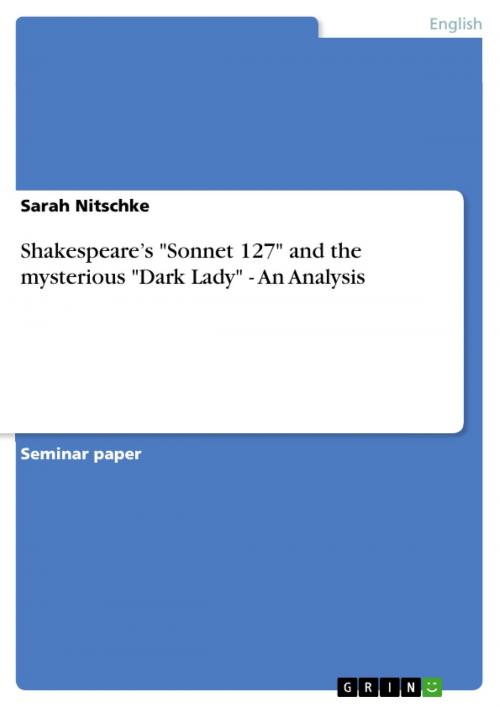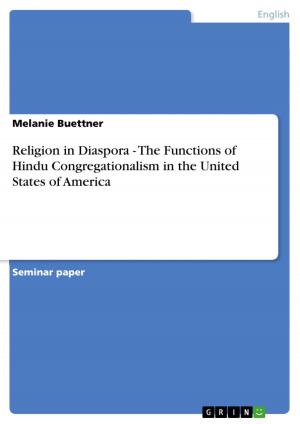Shakespeare's 'Sonnet 127' and the mysterious 'Dark Lady' - An Analysis
An Analysis
Fiction & Literature, Literary Theory & Criticism, British| Author: | Sarah Nitschke | ISBN: | 9783640593569 |
| Publisher: | GRIN Publishing | Publication: | April 15, 2010 |
| Imprint: | GRIN Publishing | Language: | English |
| Author: | Sarah Nitschke |
| ISBN: | 9783640593569 |
| Publisher: | GRIN Publishing |
| Publication: | April 15, 2010 |
| Imprint: | GRIN Publishing |
| Language: | English |
Seminar paper from the year 2010 in the subject English Language and Literature Studies - Literature, grade: 1,3, University of Erfurt, language: English, abstract: For about thirty years sonnet sequences were popular in England (1580s to the 1610s) . A sonnet is a poem of 14 lines of iambic pentameter with an elaborate rhyme scheme. The poets of these forms of poems wrote in order to express their deep human emotions. Especially, poets in Renaissance revealed the philosophy of humanism. Poets of Elizabethan time are mainly concerned with the subject of love. Thereby, they made use on metaphoric and poetic conventions which were developed by Italian poets of the fourteenth century like Petrarch or Dante. The Petrarchan, or Italian sonnet, consists of two quatrains and two tercets. To emphasize the idea of the poem, the rhyme scheme and structure work together. William Shakespeare reshaped the sonnet structure. The English, or Shakespearean sonnet, consists of three quatrains and a concluding couplet. Shakespeare used, like Petrarch, the structure of the sonnet to explore multiple facets of a topic in short. He, despite his high status as a dramatist, attracted no attention as a sonneteer . William Shakespeare was born in 1564 in Stratford upon Avon. In 1609 he retracted from the London live in theatre back to the city of his birth. In the very same year the publisher Thomas Thorpe announced the book 'Shake-Speares Sonnets Never before Imprinted'. 'When [Shakespeare] published his sonnets - or allowed them to be published - in 1609, the sonnet vogue was all but over [...]' . About the background and the reliability of this edition prevails disagreement. It is not resolved whether Shakespeare had wanted the publication. It is also uncertain whether the order of the sonnets is right or does it make any sense to rearrange the sequence. Even the division of the sequence into two parts - sonnet one till 126 address a young man and sonnet 127 till 154 address the Dark Lady - is questionable because many of the sonnets have no gender-markers. However, most editors accept the ordering from the 1609 edition . With 154 poems, Shakespeare wrote the longest sonnet cycle of the Elizabethan age. If we comply with the assumption of most editors, the poems one till 126 focuses a young blonde man, and the sonnets 127 till 152 are aimed at a Dark Lady who is the 'conceptual antithesis of the young man' . The whole sequence ends with two rather insignificant love sonnets which have nothing to do with the previous sonnets.
Seminar paper from the year 2010 in the subject English Language and Literature Studies - Literature, grade: 1,3, University of Erfurt, language: English, abstract: For about thirty years sonnet sequences were popular in England (1580s to the 1610s) . A sonnet is a poem of 14 lines of iambic pentameter with an elaborate rhyme scheme. The poets of these forms of poems wrote in order to express their deep human emotions. Especially, poets in Renaissance revealed the philosophy of humanism. Poets of Elizabethan time are mainly concerned with the subject of love. Thereby, they made use on metaphoric and poetic conventions which were developed by Italian poets of the fourteenth century like Petrarch or Dante. The Petrarchan, or Italian sonnet, consists of two quatrains and two tercets. To emphasize the idea of the poem, the rhyme scheme and structure work together. William Shakespeare reshaped the sonnet structure. The English, or Shakespearean sonnet, consists of three quatrains and a concluding couplet. Shakespeare used, like Petrarch, the structure of the sonnet to explore multiple facets of a topic in short. He, despite his high status as a dramatist, attracted no attention as a sonneteer . William Shakespeare was born in 1564 in Stratford upon Avon. In 1609 he retracted from the London live in theatre back to the city of his birth. In the very same year the publisher Thomas Thorpe announced the book 'Shake-Speares Sonnets Never before Imprinted'. 'When [Shakespeare] published his sonnets - or allowed them to be published - in 1609, the sonnet vogue was all but over [...]' . About the background and the reliability of this edition prevails disagreement. It is not resolved whether Shakespeare had wanted the publication. It is also uncertain whether the order of the sonnets is right or does it make any sense to rearrange the sequence. Even the division of the sequence into two parts - sonnet one till 126 address a young man and sonnet 127 till 154 address the Dark Lady - is questionable because many of the sonnets have no gender-markers. However, most editors accept the ordering from the 1609 edition . With 154 poems, Shakespeare wrote the longest sonnet cycle of the Elizabethan age. If we comply with the assumption of most editors, the poems one till 126 focuses a young blonde man, and the sonnets 127 till 152 are aimed at a Dark Lady who is the 'conceptual antithesis of the young man' . The whole sequence ends with two rather insignificant love sonnets which have nothing to do with the previous sonnets.















